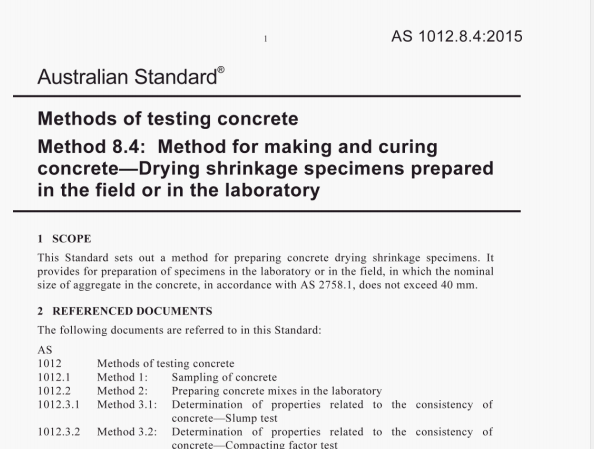AS 1012.8.4:2015 pdf – Methods of testing concrete Method 8.4: Method for making and curing concrete-Drying shrinkage specimens prepared in the field or in the laboratory.
Each specimen shall be identified by the mould marking or by other means which will not adversely affect the concrete. Scratch markings shall not be used.
NOTE: The use of permanent markings on the external face of (he mould is recommended.
6 PROCFI)URE
6.1 Measurement of consistence
The procedure is as follows:
(a) Measure slump and, if required. other consistence, in accordance with AS 1012 Methods 3.1, 3.2. 3.3. 3.4. 3.5. as appropriate.
(b) Record the temperature of the concrete at the lime of moulding.
6.2 Moulding specimens
6.2.1 Moulding procedure
The apparatus and the specimen are prepared as follows:
(a) Treat assembled drying shrinkage moulds to prevent adhesion of the concrete by the use of a thin coating of mineral oil or other suitable release compound applied to the whole of the inside surfaces of each mould.
(b) Prepare the gauge stud assembly as follows:
(I) Lubricate the threading of the gauge stud holder.
(ii) Screw the gauge stud into the gauge stud holder, taking care that no mineral oil or other contaminant remains on the surface of the gauge stud which comes into contact with the concrete.
(iii) Using the length gauge (see Clause 4.3), set the effective gauge length, i.e. the length between the innermost ends of the gauge studs, at 250 mm.
(c) Take the sample of concrete as quickly as possible to the place selected for moulding the specimens.
(d) After a minimum of mixing to ofEset any segregation that has occurred during transportation, commence moulding without delay.
(e) Complete moulding within 30 mm of the completion of obtaining the lest sample. NOTE: This may not always be possible [or concrete sampled in thc field, Where this is thc case, variations should be noed in hc report.
(f) Using a scoop, place concrete in the mould in two approximately equal layers ensuring symmetrical distribution of the concrete within the mould.
(g) Compact the concrete by tamping or vibrating, as appropriate, as described in Clause 6.2.2 or Clause 6.2.3 without causing segregation or excessive laitance.
NOTE: Thc object is to achieve full compaction. Compaction by tamping is not recommended for concrete with a slump less than 40 mm. nor is vibration recommended for concrete with a slump greater than 100 mm.
AS 1012.8.4:2015 pdf – Methods of testing concrete Method 8.4: Method for making and curing concrete-Drying shrinkage specimens prepared in the field or in the laboratory
